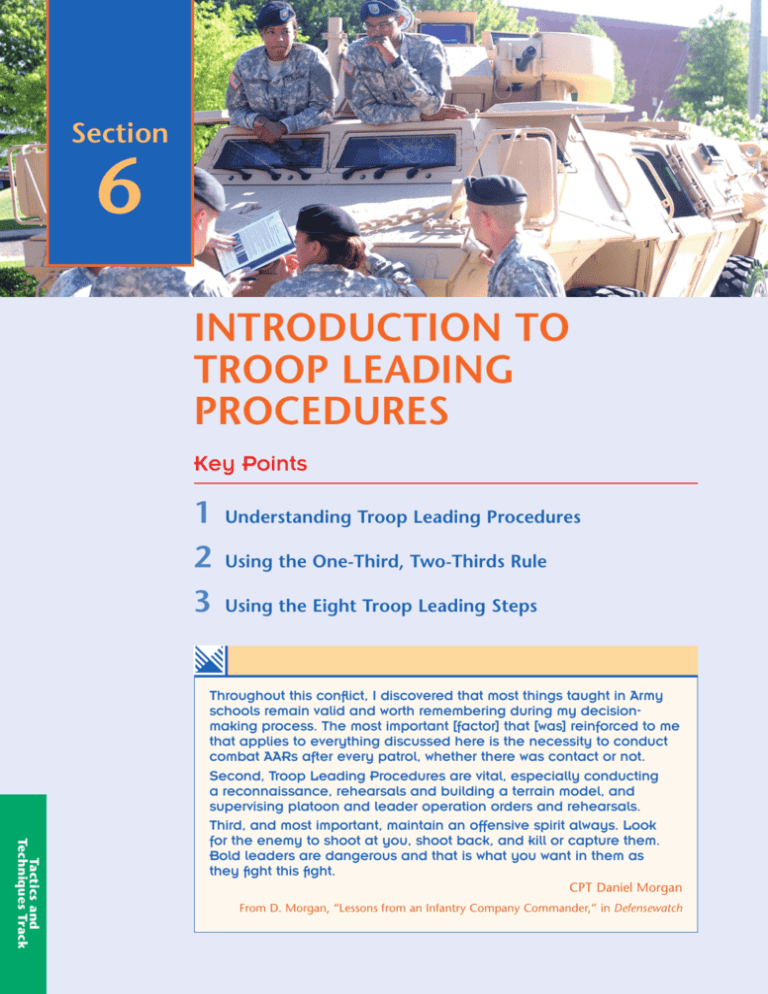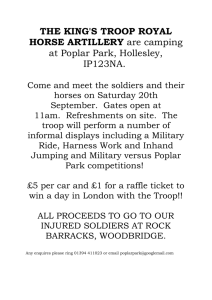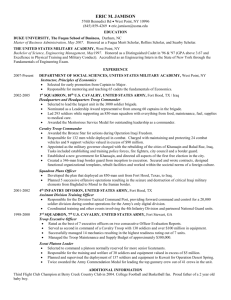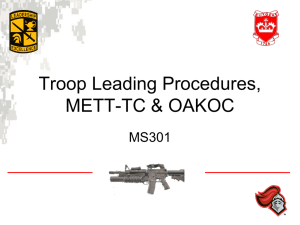INTRODUCTION TO TROOP LEADING PROCEDURES
advertisement

Section 6 INTRODUCTION TO TROOP LEADING PROCEDURES Key Points 1 2 3 Understanding Troop Leading Procedures Using the One-Third, Two-Thirds Rule Using the Eight Troop Leading Steps e Tactics and Techniques Track Throughout this conflict, I discovered that most things taught in Army schools remain valid and worth remembering during my decisionmaking process. The most important [factor] that [was] reinforced to me that applies to everything discussed here is the necessity to conduct combat AARs after every patrol, whether there was contact or not. Second, Troop Leading Procedures are vital, especially conducting a reconnaissance, rehearsals and building a terrain model, and supervising platoon and leader operation orders and rehearsals. Third, and most important, maintain an offensive spirit always. Look for the enemy to shoot at you, shoot back, and kill or capture them. Bold leaders are dangerous and that is what you want in them as they fight this fight. CPT Daniel Morgan From D. Morgan, “Lessons from an Infantry Company Commander,” in Defensewatch Introduction to Troop Leading Procedures Introduction You use procedures every day. You change your flat tire with a procedure: You loosen the lug nuts, you jack up the car, you remove the nuts, you remove the flat, you put on the spare, you replace the nuts, you lower the car, you tighten the nuts. What happens when you violate the procedure? What happens when you jack up the car before you have loosened the lug nuts? The wheel spins and you can’t loosen the nuts. It doesn’t work. The Army has procedures for leading troops. The Army calls them—not surprisingly—troop leading procedures (TLP). When you follow them, you increase the likelihood of accomplishing your mission and minimizing casualties. If you do not follow them, you will endanger your Soldiers and your mission, as a new commander found when he arrived at his post in Vietnam. Receiving the New Mission: Taking Command of a Battalion in Combat [Sergeant Major] Press came back from his first circuit of [Fire Base] Dizzy shaking his head. “I wouldn’t even call it a firebase,” he said. “I don’t know what it is—it kind of looks like a picnic area. I mean, it’s like some kind of outing with the local Kiwanis or something. I looked around and seen no one wearing helmets. No one carrying their weapons. Everybody in the CP [command post] group was sleeping above ground. I didn’t see a foxhole anywhere. Sir, this outfit stinks worse than we thought.” “Top,” I replied. “As soon as I take over tomorrow, I want you to have the company commanders and staff assembled. While I meet with them, how about you getting together with the first sergeants? They haven’t been doing their jobs, or this outfit wouldn’t be in this shape. Really smoke ‘em. Between us, we’ll get things straightened out.” He shot me a pitying look. “Right, Colonel. You, me, and John Wayne.” David H. Hackworth and Eilhys England, Steel My Soldiers’ Hearts n 291 292 n SECTION 6 Understanding Troop Leading Procedures Command Command is the authority that a commander in the military service lawfully exercises over subordinates by virtue of rank or assignment. Command includes the leadership, authority, responsibility, and accountability for effectively using available resources and planning the employment of, organizing, directing, coordinating, and controlling military forces to accomplish assigned missions. It includes responsibility for unit readiness, health, welfare, morale, and discipline of assigned personnel. Although you conduct in-depth mission analysis during Step 3, you cannot issue your WARNO (Step 2) without first having done a rudimentary mission analysis to derive your mission and intent from higher headquarters’ mission and the intent given to you in higher headquarters’ order. The Army uses command and control—with the emphasis on command. Decision making will usually rest with the leader on the ground closest to the fight—the leader with the clearest awareness of the situation. The first opportunity to command is at the company level. As platoon leader, however, you will have the maximum freedom to lead, limited only by your company commander’s or battalion commander’s need to synchronize your actions with the actions of the other platoons under their command. With that freedom you will use troop leading procedures, which the previous section introduced you to as part of the Army problem solving process, to prepare your unit to accomplish its tactical missions. Troop leading procedures begin when you are alerted for a mission by an order. TLP continue until your mission ends when you receive a fragmentary order or a new warning order or operation order. Once you receive a new mission, the TLP start again. The troop leading procedures include eight steps: 1. 2. 3. 4. 5. 6. 7. 8. Receive the mission Issue a warning order Make a tentative plan Start necessary movement Reconnoiter Complete the plan Issue the complete order Supervise. While Steps 1 and 2 are completed in order, Steps 3 through 8 may not follow a rigid sequence. You may complete many of the steps at the same time. In combat, you may not have enough time to go through each step in detail, but you must use the procedure to make sure you leave nothing out. The amount of time you have will dictate the amount of detail you will go into with each step of the procedure. You will update and adjust your plan as you receive new information. Using the One-Third, Two-Thirds Rule After you receive your mission, time is often limited, so you must use it wisely. Of all the resources available to you, time is the only resource that you can never get back. You should use no more than one-third of your available time for planning and issuing your operation order. Your subordinates need the remaining two-thirds of the time to plan and prepare their parts of the mission. This is known as the “one-third, two-thirds rule.” • In the offense, use no more than one-third of the time between the moment you receive your mission and the time you begin your attack • In the defense, use no more than one-third of the time from the moment you receive your mission to the time your platoon must be ready to defend. e Critical Thinking What are the advantages of having established procedures? Are there any disadvantages? Introduction to Troop Leading Procedures To help in allotting your time well, use reverse or backward planning—work backward from the time you must attack or defend. Suppose you receive a mission to attack Hill 255 at 0315 (3:15 a.m.) tomorrow morning. It is now 2030 (8:30 p.m.). Some quick math shows that you have six hours and 45 minutes before the attack. You should plan to issue your final plan (OPORD) in a little more than two hours, or by 2245 at the latest. Your Soldiers need the other four-and-a-half hours to organize, conduct reconnaissance, draw resources to support the mission, conduct rehearsals and inspections, and navigate to and occupy the assault position prior to 0315. If you use up more than your one-third of the time, then your Soldiers will not have the time to properly prepare for the mission. Make sure you remain true to the one-third, twothirds rule so your Soldiers will always have enough time to complete each task. Using the Eight Troop Leading Steps STEP 1—Receive the Mission Your mission may come in a warning order (WARNO), an operation order (OPORD), or a fragmentary order (FRAGO). You use the factors represented by the acronym METT-TC to analyze your mission: e Use METT-TC to Analyze Your Mission M What is your mission? Consider your mission as your commander has given it to you. Consider the context of your mission in light of the commander’s intent two command levels higher than you. In other words, if you are a platoon leader, what does your battalion commander want to accomplish? Identify the step-by-step tasks you and your unit must accomplish to complete the mission. You will write your restated mission ensuring you cover the five Ws (who, what, where, when, why) and how. E What do you know about the enemy? Who are you up against? Consider the type, size, organization, tactics, and equipment of enemy forces. Identify their most likely course of action and their most dangerous course of action. T How will terrain and weather affect your mission? Use the acronym OAKOC, which you learned in Section 2, Land Navigation, to evaluate the effects of terrain and weather on your upcoming mission, as well as how the terrain and weather will affect the enemy. (See Table 6.1.) T What troops do you have? Consider your Soldiers’ strength, numbers, and weapons. Consider the capabilities of any attached units. Assign tasks appropriate to the number of Soldiers in each subelement. T How much time do you have? Use your time wisely. Allocate your time based on your plan and any possible changes to the situation. Adhere to the onethird, two-thirds rule to help you prioritize your tasks that must be completed versus those that you must set aside due to time constraints. C How will your mission affect civilians? Consider the population, the culture, and the leaders. For example, churches, temples, mosques, and other places of worship have had a respected status for centuries. The success of your mission may depend on the goodwill of the civilian population. n 293 warning order (WARNO) an order that alerts the troops to an upcoming offensive or defensive mission and contains enough information to begin preparing as soon as possible operation order (OPORD) an order that gives the troops the details they need to conduct an offensive or defensive operation—an OPORD usually includes five paragraphs: situation, mission, execution, service support, and command and signal. fragmentary order (FRAGO) an abbreviated form of an OPORD—it can be verbal, written, or digital METT-TC an Army acronym that helps commanders plan an operation—it stands for Mission, Enemy, Terrain, Troops available, Time, and Civilian considerations commander’s intent what your commander, usually two levels up (squad to company, platoon to battalion, or company to brigade), wants to accomplish— understanding the commander’s intent allows mission-type guidance and gives the ground commander freedom to operate within that intent 294 n SECTION 6 e Critical Thinking How—and why—might the success of your mission depend on the goodwill of the civilian population? TA B L E 6 . 1 Use OAKOC to Evaluate the Effects of Terrain and Weather O Observation and fields of fire. What can you see throughout your area? What fields of fire will you have in terms of maximum effective range, grazing fire, and the arming range and time of flight for anti-armor weapons? How will the weather affect your visibility? The enemy’s visibility? A Avenues of approach. An avenue of approach is a route or axis of advance to an objective or to key terrain. You must always consider speed versus protection when selecting avenues of approach. If you are attacking, which avenues of approach will give your Soldiers their greatest protection? Which avenues of approach will place you and your Soldiers at your enemy’s most vulnerable spot? Which avenue of approach offers the best speed to enhance the element of surprise? How will the light and weather affect your ability to move, shoot, and communicate along your avenue of approach? If you are defending, which is the enemy’s most probable avenue of approach? Which avenue of approach would be the most deadly to your defense? Do you have the right weapons to cover the enemy’s most probable or deadliest avenue of approach? Anticipate what the enemy may do. Ask yourself, “If I were attacking, how would I do it?” How will the light and weather affect the enemy’s ability to shoot, move, and communicate on the avenue of approach? Which avenues of approach can you select that will support a counterattack? K Key and decisive terrain. What terrain in your area of operation, if controlled by you or the enemy, would give a marked advantage during the fight? Where is the high ground and does it afford a tactical or strategic advantage? Is any of the key terrain decisive terrain? How will the weather or light affect your ability to seize, secure, or defend key and decisive terrain? O Obstacles. If you are attacking, what existing or man-made objects will restrict your ability to maneuver? If you are defending, what existing or man-made objects can you use to tie in with your defensive plan? How will the light and weather affect the obstacle’s ability to disrupt, turn, fix, or block the enemy? C Cover and concealment. What terrain will protect you and your Soldiers from direct and indirect fire (cover) and from aerial and ground observation (concealment)? How will the light or weather aid or hinder your cover and concealment? Introduction to Troop Leading Procedures STEP 2—Issue a Warning Order (WARNO) Keep your Soldiers informed. Let them know immediately—through their chain of command —what they need to know to begin planning and preparing for the next mission. Do not wait. Issue your warning order as soon after you have received it from higher headquarters with the information you have. Update it as often as necessary. Your order will follow the “five-paragraph format” you will study later. Go with the information you have and disseminate only the information that your Soldiers need to know right then and there to start preparing for the mission. You can give out other information as time permits or in the OPORD. Remember the one-third, two-thirds rule. Your warning order should include at a minimum as many of the five W’s (who, what, where, when, and why) as you derived from higher command’s order in addition to the time and place that you will issue your OPORD. STEP 3—Make a Tentative Plan Develop an estimate of the situation to begin your plan. Apply as much of the Army problem solving process as time permits when developing your tentative plan. As you studied earlier, the seven steps are: 1. Identify the problem. What is my mission? 2. Gather information. What do I know about the enemy, terrain, weather, and light? 3. 4. 5. 6. 7. What do I know about my own troops and attachments? What do I know about higher headquarters’ mission and intent? What is the mission of adjacent units? What classes of supplies will I need to support my mission? What are my transportation requirements? Where will my higher command be during the operation and how will I maintain contact with them? What signals are available to me and how and when will I use them? Develop criteria. What are the critical tasks that my unit must perform if the mission is to succeed? What are the risks? Are some criteria more important than others? Should I weight my criteria to reflect how critical each is to mission success? Generate possible solutions. How many different ways (courses of action) can my unit accomplish this mission? Analyze possible solutions. What are the pros and cons for each course of action? How do facts derived in Step 2 affect the expected outcome for each course of action? Compare possible solutions. How well does each of my courses of action meet or achieve higher headquarters’ mission and intent, and my critical tasks? Make and implement your decision. Select the course of action that best achieves the most critical task, or achieves the most critical tasks your unit must accomplish in order for the mission to succeed. The course of action that seizes or secures decisive terrain, meets a critical deadline, or meets a commander’s critical information requirements is in many cases the best course of action to take. n 295 296 n SECTION 6 Murphy’s Law “whatever can go wrong, will go wrong”; originated with CPT Edward A. Murphy, USAF—Murphy was a test pilot and engineer at Edwards Air Force Base, who coined the term in 1949 The last step of your estimate of the situation—your decision—is your tentative plan. When you receive new information, update your estimate, and refine your plan. Use your plan as a starting point to coordinate, conduct reconnaissance, organize, and move. Work through the problem solving process in as much detail as time allows. You base your estimate on the factors of METT-TC and OAKOC. At this point, you must be aware of and take action to overcome “Murphy’s Law”: Whatever can go wrong, will go wrong. STEP 4—Start Necessary Movement Your platoon may need to begin moving while you are still planning. Start necessary movement can mean many things, but is not limited to Soldiers’ or vehicles’ physical movement. Your platoon sergeant or squad leaders may begin to move the platoon forward to pre-position it closer to the line of departure or the tentative defensive position. Going out on a leader’s recon or sending out a recon party are also examples of starting necessary movement. Other examples are conducting inventories of supplies and equipment and requisitioning those that are short. This step could occur at any time during the troop leading procedure. Moving out early and as far forward as possible helps to negate the effects of Murphy’s Law, because it will help flush problems out of hiding. You may need to adjust the movement depending on what you learn in the next step. STEP 5—Reconnoiter If you have time, you should make a personal reconnaissance to conduct your terrain analysis, confirm your routes, time your movements, and adjust your plan as necessary. Consider the risks involved in conducting a recon forward of your lines. If you don’t have time for a personal recon, you can task your most experienced squad leader to lead a recon party (your platoon sergeant will be handling your personnel and logistical requirements to support the upcoming mission). If you do not have the time or qualified personnel to conduct the recon, the next best recon is to study the most recent aerial photographs. The last resort is a map reconnaissance of the most current map of your area of operations. You may also have the opportunity to talk to others who have recently returned from the area of operations, such as scouts or other leaders who have led missions in the area. Remember to balance the amount of reconnaissance you do with the amount of time you have. Remember the one-third, two-thirds rule! STEP 6—Complete the Plan Based on your reconnaissance and any changes in the situation, complete your plan. At a minimum, your company commander will want a back-brief on your plan to ensure that your plan meets the commander’s intent. If time permits, it may be wise to have a more experienced peer or your platoon sergeant review your plan before taking it to your company commander. Make sure your plan meets your commander’s intent. STEP 7—Issue the Complete Order As a platoon leader, you will normally issue oral operation orders; they will not be in writing. However, you will base your oral order on a written product, no matter how abbreviated or scribbled, that you developed during the previous six steps. It is always a good idea to keep a copy of your written order for the historical record. Introduction to Troop Leading Procedures If time permits, review the plan with your platoon sergeant. Whenever possible, you should issue your order within sight of the objective or on the terrain you intend to defend. If you can’t do this, use a terrain model or a sketch. Make sure your Soldiers understand their mission, their commander’s intent (two levels above), the concept of the operation, and their assigned tasks. At the end of your order, and before you release your platoon, conduct a back-brief (ask questions about key tasks) with your squad leaders, and if time permits, continue your back-brief down to your team leaders and further down to individual Soldiers who have a critical task to perform. The key to the back-brief is asking questions about the most critical of tasks to ensure that if nothing else goes right, at least your Soldiers know how to accomplish their tasks. e Critical Thinking Discuss the advantages of having your Soldiers feed back all or part of the order. What does that accomplish? n 297 298 n SECTION 6 STEP 8—Supervise Prepare your platoon with well-supervised rehearsals and inspections. During the planning and reconnaissance steps, you should delegate supervision to a subordinate leader to conduct inspections and rehearsals so that you can conduct your leader’s reconnaissance and finalize your plan. Good leaders set aside at least enough time to conduct a final inspection and rehearse actions on the objective. Inspections Your squad leaders should inspect their Soldiers soon after they receive the warning order. Your platoon sergeant should make spot checks. You and your platoon sergeant should make the final inspection. You must inspect: • • • • • • • • Weapons and ammunition Uniforms and equipment Mission-essential equipment Soldiers’ understanding of the mission and their specific responsibilities Communications Rations and water Camouflage Deficiencies noted during earlier inspections. During your final inspection, spot check those key personnel who have critical missions to see if they have the necessary supplies or equipment to complete their tasks. Rehearsals Use rehearsals to practice tasks, reveal problems in the plan, coordinate everyone’s actions, and improve everyone’s understanding of the mission. Conduct rehearsals on ground that resembles the actual ground and in similar light conditions. You may want your platoon to rehearse battle drills and other SOP items before you issue your operation order. Then when you issue the OPORD, your Soldiers can rehearse mission-specific tasks. While rehearsing actions on the objective, ensure that your rehearsal covers those critical tasks or steps that will allow you to achieve the objective. e Critical Thinking Why does the Army emphasize command over control? What advantages does the local commander on the ground have? Why does time play a critical part in the TLP? Why would you issue a warning order—even when you know you will have to come back and revise it? Introduction to Troop Leading Procedures e CONCLUSION The troop leading procedures are your checklist for preparing your Soldiers for tactical missions. You begin to implement them as soon as you receive the alert to a new mission. The amount of time you can spend on each step depends largely on the amount of time available to you. In many cases, you will not have enough time to go through each step in detail, but you must still use the procedure to ensure you leave nothing out of your preparations. Remember the “one-third, two-thirds rule” and give your subordinates as much time as possible to prepare. Throughout the troop leading procedures, be aware of Murphy’s Law. Check and double-check. It will be your attention to detail, your careful planning, and your leadership of your Soldiers that will decide the success or failure of your mission. Key Words warning order (WARNO) operation order (OPORD) fragmentary order (FRAGO) METT-TC commander’s intent Murphy’s Law Learning Assessment 1. List and explain the eight steps of the troop leading procedures. 2. Identify and explain the parts of the acronym METT-TC. 3. Identify and explain the parts of the acronym OAKOC. 4. Explain the one-third, two-thirds rule. References Field Manual 3-21.8, The Infantry Rifle Platoon and Squad. 28 March 2007. Field Manual 5-0, Army Planning and Orders Production. 20 January 2005. Hackworth, D., & England, E. (2003). Steel My Soldiers’ Hearts. New York: Simon and Schuster. Morgan, D. (13 February 2004). Lessons from an Infantry Company Commander. Defensewatch. Retrieved 4 August 2005 from http://www.military.com/NewContent/ 0,13190,Defensewatch_021304_Lessons,00.html n 299







